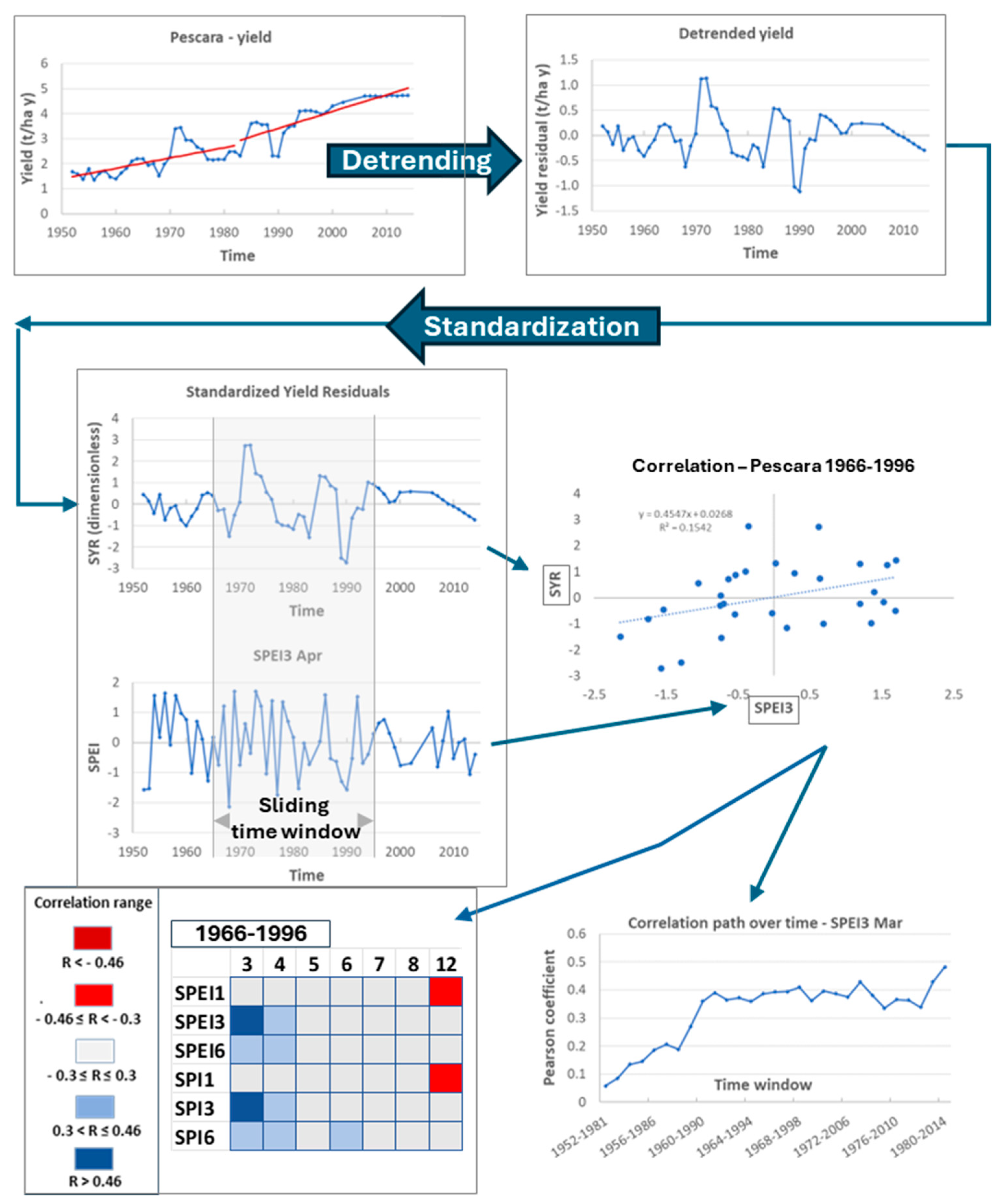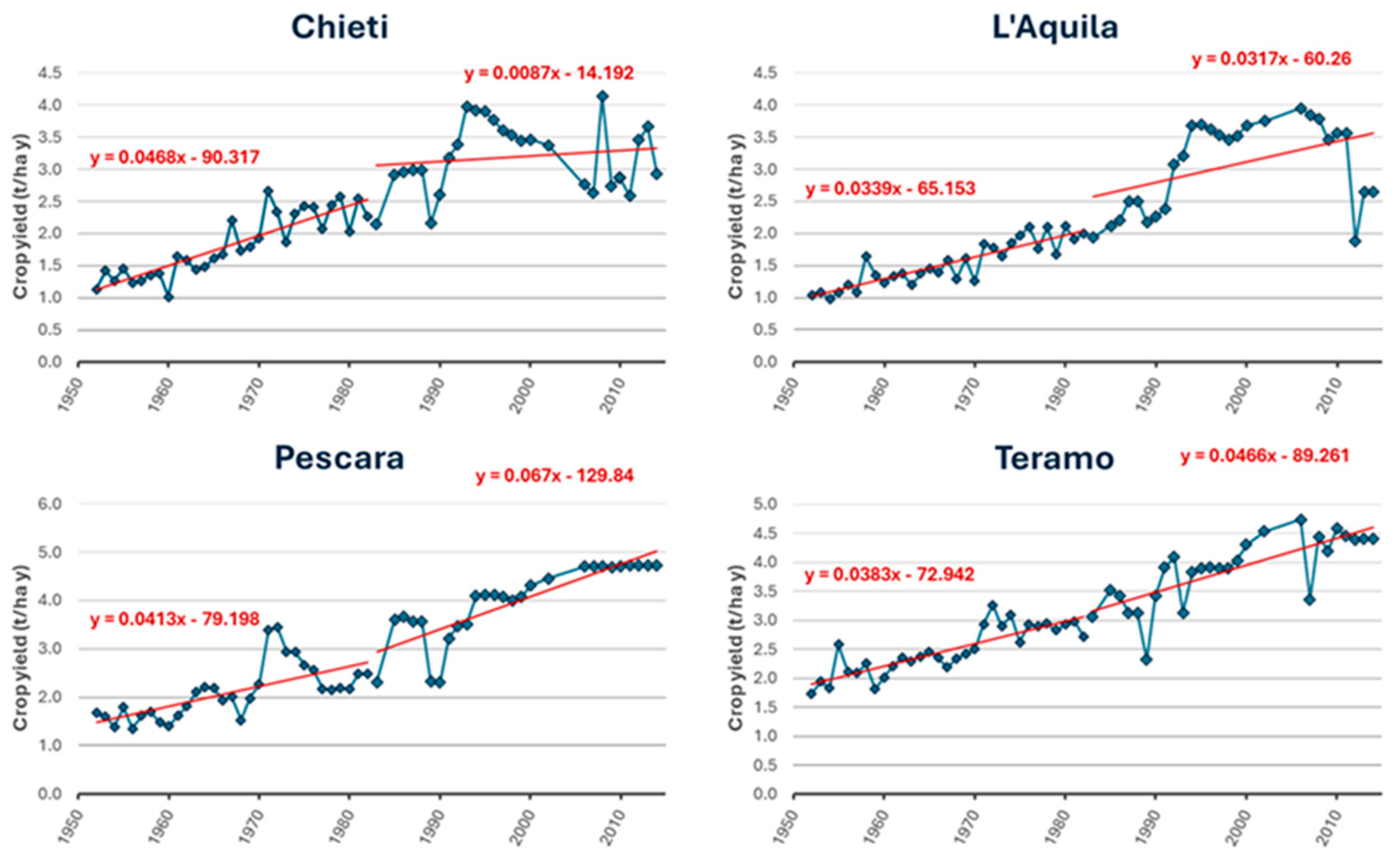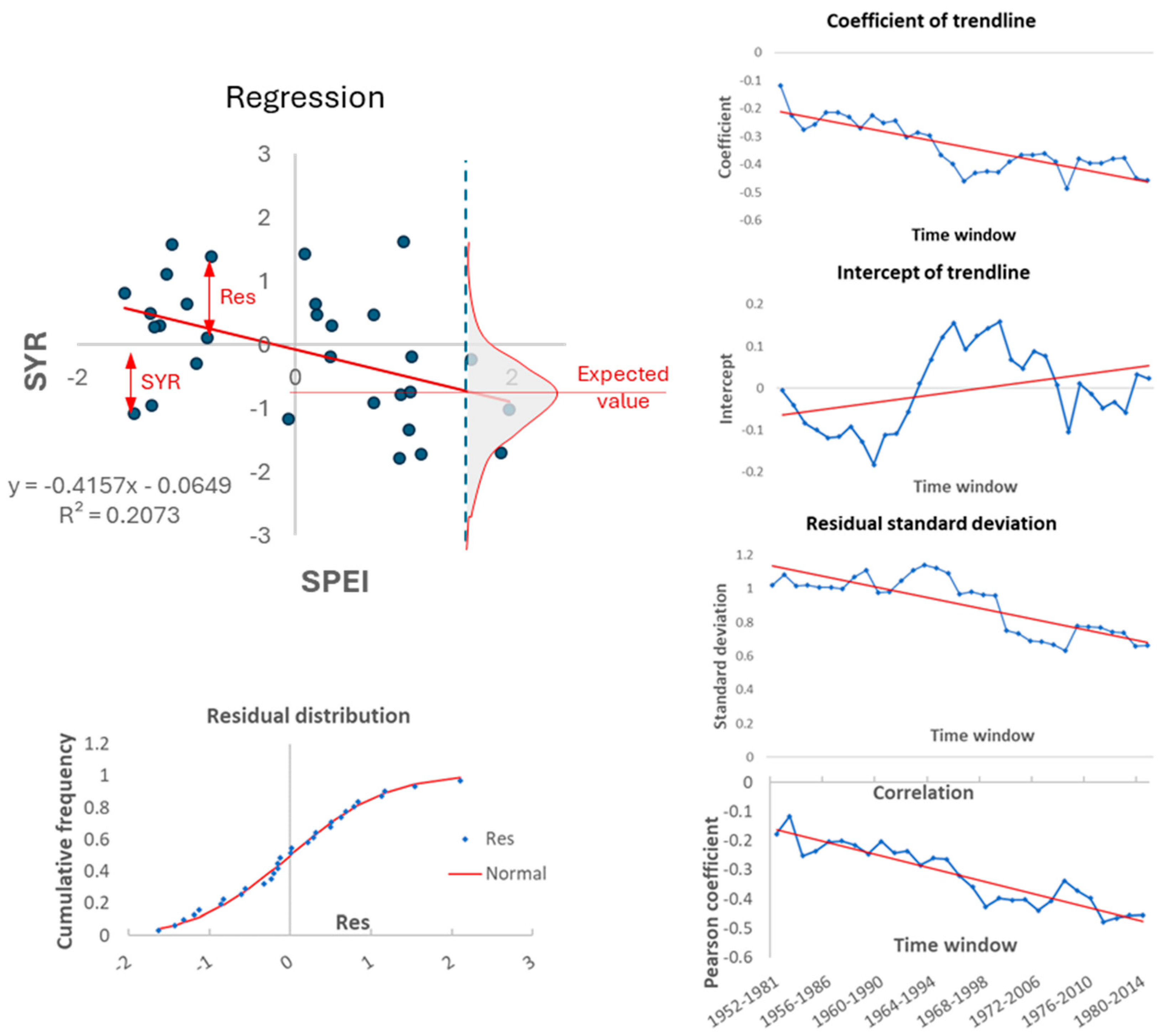Measuring Variation of Crop Production Vulnerability to Climate Fluctuations over Time, Illustrated by the Case Study of Wheat from the Abruzzo Region (Italy)
Abstract
1. Introduction
2. Materials and Methods
2.1. Geomorphology, Climate of the Study Area, and Crop Production Data
2.2. Joint Analysis of Thermo-Pluviometric and Crop Yield Time Series
- Changing sensitivity to climate fluctuations: an overall increase (or decrease) in the number of colored cells and/or dark cells (blue or red) over time can be interpreted as an enhanced (or reduced) sensitivity of the crop production system to climatic fluctuations.
- Shifting vulnerabilities: the migration of colored cells from one area of the panel to another can shed light on the specific periods of the year or phenological stages that become increasingly important in terms of the climate vulnerability of yield.
- Identifying dominant drought indices: by examining the trend of correlation coefficients for the most impactful drought indices, the study can identify the indices that exhibit the most pronounced and consistent trends over time. These indices serve as valuable tools for monitoring and predicting climate-induced yield variations.
3. Results and Discussion
3.1. Crop Yield Trends
3.2. Correlation Analysis
4. Perspective for Future Research
5. Conclusions
- The individuated correlation trends can be interpreted as a growing sensitivity of the Abruzzo wheat production system to climate fluctuations. The observed results provide a picture of the climate adaption characteristics of the wheat production system. This adaptation has led to progressive increases in wheat yield, but it has not mitigated the impact of short-term climate fluctuations.
- The dominant SPI and SPEI indices were identified for each wheat-producing province, further pinpointing the periods of the year and corresponding phenological stages when the production system appears most vulnerable.
- Different provinces have shown diverse responses over time, even if they are neighboring one another. Therefore, when designing this kind of analysis, the observation scale must be carefully evaluated.
- This study delves into the temporal dynamics of the wheat yield response to climate fluctuations in Abruzzo, offering valuable insights into the evolving climate–yield relationship.
- The statistical approach illustrated provides a robust framework for monitoring climate impacts on crop yields
- These results also provide the basis for developing predictive models to support informed decision making in agricultural management and financial planning.
Author Contributions
Funding
Institutional Review Board Statement
Informed Consent Statement
Data Availability Statement
Acknowledgments
Conflicts of Interest
References
- Lobell, D.B.; Field, C.B. Global scale climate–crop yield relationships and the impacts of recent warming. Environ. Res. Lett. 2007, 2, 014002. [Google Scholar] [CrossRef]
- Kang, Y.; Khan, S.; Ma, X. Climate change impacts on crop yield, crop water productivity and food security—A review. Prog. Nat. Sci. 2009, 19, 1665–1674. [Google Scholar] [CrossRef]
- Deschênes, O.; Greenstone, M. Climate Change, Mortality, and Adaptation: Evidence from Annual Fluctuations in Weather in the US. Am. Econ. J. Appl. Econ. 2011, 3, 152–185. [Google Scholar] [CrossRef]
- Deschênes, O.; Greenstone, M. The Economic Impacts of Climate Change: Evidence from Agricultural Output and Random Fluctuations in Weather: Reply. Am. Econ. Rev. 2012, 102, 3761–3773. [Google Scholar] [CrossRef]
- Lobell, D.B.; Gourdji, S.M. The Influence of Climate Change on Global Crop Productivity. Plant Physiol. 2012, 160, 4. [Google Scholar] [CrossRef] [PubMed]
- Segerstrom, T.M. Global Climate Change, Fair Trade, and Coffee Price Volatility. Gettysbg. Econ. Rev. 2016, 9, 6. Available online: https://cupola.gettysburg.edu/ger/vol9/iss1/6 (accessed on 18 July 2024).
- Moore, F.C.; Baldos, U.L.; Hertel, T. Economic impacts of climate change on agriculture: A comparison of process-based and statistical yield models. Environ. Res. Lett. 2017, 12, 065008. [Google Scholar] [CrossRef]
- Holleman, C.; Rembold, F.; Crespo, O.; Conti, V. The impact of climate variability and extremes on agriculture and food security—An analysis of the evidence and case studies. In Background Paper for The State of Food Security and Nutrition in the World 2018; FAO Agricultural Development Economics Technical Study No. 4; FAO: Rome, Italy, 2020. [Google Scholar] [CrossRef]
- Abbass, K.; Qasim, M.Z.; Song, H.; Murshed, M.; Mahmood, H.; Younis, I. A review of the global climate change impacts, adaptation, and sustainable mitigation measures. Environ. Sci. Pollut. Res. 2022, 29, 42539–42559. [Google Scholar] [CrossRef] [PubMed]
- IPCC. Summary for Policymakers. In Climate Change 2021: The Physical Science Basis; Contribution of Working Group I to the Sixth Assessment Report of the Intergovernmental Panel on Climate Change; Masson-Delmotte, V., Zhai, P., Pirani, A., Connors, S.L., Péan, C., Berger, S., Caud, N., Chen, Y., Goldfarb, L., Gomis, M.I., et al., Eds.; Cambridge University Press: Cambridge, UK, 2021. [Google Scholar]
- Tran, A.N.; Welch, J.R.; Lobell, D.; Roberts, M.J.; Schlenker, W. Commodity prices and volatility in response to anticipated climate change. In Proceedings of the Annual Meeting of Agricultural & Applied Economics Association, Seattle, USA, 12–14 August 2012. [Google Scholar] [CrossRef]
- Zhao, Y.; Chen, X.; Lobell, D.B. An approach to understanding persistent yield variation—A case study in North China Plain. Eur. J. Agron. 2016, 77, 10–19. [Google Scholar] [CrossRef]
- Mazhar, N.; Sultan, M.; Amjad, D. Impacts of rainfall and temperature variability on wheat production in district Bahawalnagar, Pakistan from 1983–2016. Pak. J. Sci. 2020, 72, 4. [Google Scholar] [CrossRef]
- Ostberg, S.; Schewe, J.; Childers, K.; Frieler, K. Changes in crop yields and their variability at different levels of global warming. Earth Syst. Dyn. 2018, 9, 2. [Google Scholar] [CrossRef]
- Iizumi, T.; Ramankutty, N. Changes in yield variability of major crops for 1981–2010 explained by climate change. Environ. Res. Lett. 2016, 11, 034003. [Google Scholar] [CrossRef]
- Meng, Q.; Chen, X.; Lobell, D.; Cui, Z.; Zhang, Y.; Yang, H.; Zhang, F. Growing sensitivity of maize to water scarcity under climate change. Sci Rep. 2016, 6, 19605. [Google Scholar] [CrossRef] [PubMed]
- Lobell, D.B.; Roberts, M.J.; Schlenker, W.; Braun, N.; Little, B.B.; Rejesus, R.M.; Hammer, G.L. Greater Sensitivity to Drought Accompanies Maize Yield Increase in the U. S. Midwest. Sci. 2014, 344, 516–519. [Google Scholar] [CrossRef] [PubMed]
- Lobell, D.B.; Deines, J.M.; Tommaso, S.D. Changes in the drought sensitivity of US maize yields. Nat. Food 2020, 1, 729–735. [Google Scholar] [CrossRef] [PubMed]
- Palmer, W.C. Meteorological Drought; US Department of Commerce, Weather Bureau: Washington, DC, USA, 1965; Volume 30. [Google Scholar]
- McKee, T.B.; Doesken, N.J.; Kleist, J. The relationship of drought frequency and duration to time scales. In Proceedings of the 8th Conference on Applied Climatology, Anaheim, CA, USA, 17–22 January 1993; Volume 17, No. 22. pp. 179–183. [Google Scholar]
- Narasimhan, B.; Srinivasan, R. Development and evaluation of Soil Moisture Deficit Index (SMDI) and Evapotranspiration Deficit Index (ETDI) for agricultural drought monitoring. Agric. For. Meteorol. 2005, 133, 69–88. [Google Scholar] [CrossRef]
- Vicente-Serrano, S.M.; Beguería, S.; López-Moreno, J.I. A Multiscalar Drought Index Sensitive to Global Warming: The Stand-ardized Precipitation Evapotranspiration Index. J. Clim. 2010, 23, 1696–1718. [Google Scholar] [CrossRef]
- Gunst, L.; Rego, F.M.C.C.; Dias, S.M.A.; Bifulco, C.; Stagge, J.H.; Rocha, M.S.; Van Lanen, H.A.J. Links between Meteorological Drought Indices and Yields (1979–2009) of the Main European Crops; Technical Report No. 36; DROUGHT-R&SPI Project: Wa-geningen, The Netherlands, 2015. [Google Scholar]
- World Meteorological Organization (WMO); Global Water Partnership (GWP). Handbook of Drought Indicators and Indices; Svoboda, M., Fuchs, B.A., Eds.; Integrated Drought Management Programme (IDMP), Integrated Drought Management Tools and Guidelines Series 2; World Meteorological Organization (WMO) and Global Water Partnership (GWP): Geneva, Switzerland, 2016; ISBN 978-92-63-11173-9. [Google Scholar]
- Potopová, V.; Boroneanţ, C.; Boincean, B.; Soukup, J. Impact of agricultural drought on main crop yields in the Republic of Moldova. Int. J. Clim. 2016, 36, 2063–2082. [Google Scholar] [CrossRef]
- Tian, L.; Yu an, S.; Quiring, S.M. Evaluation of six indices for monitoring agricultural drought in the south-central United States. Agric. For. Meteorol. 2018, 249, 107–119. [Google Scholar] [CrossRef]
- Peña-Gallardo, M.; Vicente-Serrano, S.M.; Domínguez-Castro, F.; Beguería, S. The impact of drought on the productivity of two rainfed crops in Spain. Nat. Hazards Earth Syst. Sci. 2019, 19, 1215–1234. [Google Scholar] [CrossRef]
- Peña-Gallardo, M.; Vicente-Serrano, S.M.; Domínguez-Castro, F.; Quiring, S.; Svoboda, M.; Beguería, S.; Hannaford, J. Effectiveness of drought indices in identifying impacts on major crops across the USA. Clim. Res. 2018, 75, 221–240. [Google Scholar] [CrossRef]
- Bezdan, J.; Bezdan, A.; Blagojević, B.; Mesaroš, M.; Pejić, B.; Vranešević, M.; Pavić, D.; Nikolić-Đorić, E. SPEI-Based Approach to Agricultural Drought Monitoring in Vojvodina Region. Water 2019, 11, 1481. [Google Scholar] [CrossRef]
- Di Lena, B.; Farinelli, D.; Palliotti, A.; Poni, S.; DeJong, T.M.; Tombesi, S. Impact of climate change on the possible expansion of almond cultivation area pole-ward: A case study of Abruzzo, Italy. J. Hortic. Sci. Biotechnol. 2018, 93, 209–215. [Google Scholar] [CrossRef]
- Di Lena, B.; Curci, G.; Vergni, L.; Farinelli, D. Climatic Suitability of Different Areas in Abruzzo, Central Italy, for the Culti-vation of Hazelnut. Horticulturae 2022, 8, 580. [Google Scholar] [CrossRef]
- Leff, B.; Ramankutty, N.; Foley, J.A. Geographic distribution of major crops across the world. Glob. Biogeochem. Cycle 2004, 18, GB1009. [Google Scholar] [CrossRef]
- Food and Agriculture Organization FAOSTAT: Crops and Livestock Products. Available online: https://www.fao.org/faostat/en/#data/QCL/visualize. (accessed on 12 May 2024).
- Tuel, A.; Eltahir, E.A. Why is the Mediterranean a climate change hot spot? J. Clim. 2020, 33, 5829–5843. [Google Scholar] [CrossRef]
- Giorgi, F.; Lionello, P. Climate change projections for the Mediterranean region. Glob. Planet. Chang. 2008, 63, 90–104. [Google Scholar] [CrossRef]
- Scorzini, A.R.; Leopardi, M. Precipitation and temperature trends over central Italy (Abruzzo Region): 1951–2012. Theor. Appl. Clim. 2018, 135, 959–977. [Google Scholar] [CrossRef]
- Michaelides, S.; Karacostas, T.; Sánchez, J.L.; Retalis, A.; Pytharoulis, I.; Homar, V.; Romero, R.; Zanis, P.; Giannakopoulos, C.; Bühl, J.; et al. Reviews and perspectives of high impact atmospheric processes in the Mediterranean. Atmos. Res. 2018, 208, 4–44. [Google Scholar] [CrossRef]
- Fioravanti, G.; Piervitali, E.; Desiato, F. A new homogenized daily data set for temperature variability assessment in Italy. Int. J. Clim. 2019, 39, 5635–5654. [Google Scholar] [CrossRef]
- Aruffo, E.; Di Carlo, P. Homogenization of instrumental time series of air temperature in Central Italy (1930–2015). Clim. Res. 2019, 77, 193–204. [Google Scholar] [CrossRef]
- Caporali, E.; Lompi, M.; Pacetti, T.; Chiarello, V.; Fatichi, S. A review of studies on observed precipitation trends in Italy. Int. J. Climatol. 2021, 41, E1–E25. [Google Scholar] [CrossRef]
- Curci, G.; Guijarro, J.A.; Di Antonio, L.; Di Bacco, M.; Di Lena, B.; Scorzini, A.R. Building a local climate reference dataset: Application to the Abruzzo region (Central Italy), 1930–2019. Int. J. Clim. 2021, 41, 4414–4436. [Google Scholar] [CrossRef]
- Guerriero, V.; Scorzini, A.R.; Di Lena, B.; Iulianella, S.; Di Bacco, M.; Tallini, M. Impact of Climate Change on Crop Yields: Insights from the Abruzzo Region, Central Italy. Sustainability 2023, 15, 14235. [Google Scholar] [CrossRef]
- Mann, H.B. Non-Parametric Test against Trend. Econometrica 1945, 13, 245–259. [Google Scholar] [CrossRef]
- Péguy, C.P. Précis de Climatologie, 2nd ed.; Masson: Paris, France, 1970; 468p. [Google Scholar]
- Cosentino, D.; Asti, R.; Nocentini, M.; Gliozzi, E.; Kotsakis, T.; Mattei, M.; Esu, D.; Spadi, M.; Tallini, M.; Cifelli, F.; et al. New insights into the onset and evolution of the central Apennine extensional intermontane basins based on the tectonically active L’Aquila Basin (central Italy). Bull. Geol. Soc. Am. 2017, 129, 1314–1336. [Google Scholar] [CrossRef]
- Sciortino, A.; Marini, R.; Guerriero, V.; Mazzanti, P.; Spadi, M.; Tallini, M. Satellite A-DInSAR pattern recognition for seismic vulnerability mapping at city scale: Insights from the L’Aquila (Italy) case study. GISci. Remote Sens. 2024, 61, 1. [Google Scholar] [CrossRef]
- Sciortino, A.; Guerriero, V.; Marini, R.; Spadi, M.; Mazzanti, P.; Tallini, M. Geological and Hydrogeological Drivers of Seismic Deformation in L’Aquila, Italy: Insights from InSAR Analysis. Geomat. Nat. Hazards Risk 2024, 15, 2362395. [Google Scholar] [CrossRef]
- ISTAT, Biblioteca Digitale-Annuario di Statistica Agraria. Available online: https://ebiblio.istat.it/SebinaOpac/resource/annuario-di-statistica-agraria/IST0010796 (accessed on 15 August 2023).
- ISTAT, Dati-Agricoltura-Coltivazioni-Superfici e Produzione. Available online: http://dati.istat.it (accessed on 15 August 2023).
- Annali Idrologici della Regione Abruzzo, Ufficio Idrografico e Mareografico—Pescara. Available online: https://www.regione.abruzzo.it/content/annali-idrologici?page=2 (accessed on 15 August 2023).
- Annali Idrologici della Regione Campania, Centro Funzionale Multirischi della Protezione Civile Regione Campania, Annali Idrologici e Altre Pubblicazioni del Compartimento di Napoli del S.I.M.N. Available online: http://centrofunzionale.regione.campania.it/#/pages/documenti/annali (accessed on 15 August 2023).
- National Drought Mitigation Center SPI Generator [Software]. University of Nebraska–Lincoln. 2018. Available online: https://drought.unl.edu/Monitoring/SPI/SPIProgram.aspx (accessed on 12 May 2024).
- Begueria, S.; Vicente-Serrano, S.M. SPEI Calculator. 2009. Available online: http://hdl.handle.net/10261/10002 (accessed on 12 May 2024).





Disclaimer/Publisher’s Note: The statements, opinions and data contained in all publications are solely those of the individual author(s) and contributor(s) and not of MDPI and/or the editor(s). MDPI and/or the editor(s) disclaim responsibility for any injury to people or property resulting from any ideas, methods, instructions or products referred to in the content. |
© 2024 by the authors. Licensee MDPI, Basel, Switzerland. This article is an open access article distributed under the terms and conditions of the Creative Commons Attribution (CC BY) license (https://creativecommons.org/licenses/by/4.0/).
Share and Cite
Guerriero, V.; Scorzini, A.R.; Di Lena, B.; Di Bacco, M.; Tallini, M. Measuring Variation of Crop Production Vulnerability to Climate Fluctuations over Time, Illustrated by the Case Study of Wheat from the Abruzzo Region (Italy). Sustainability 2024, 16, 6462. https://doi.org/10.3390/su16156462
Guerriero V, Scorzini AR, Di Lena B, Di Bacco M, Tallini M. Measuring Variation of Crop Production Vulnerability to Climate Fluctuations over Time, Illustrated by the Case Study of Wheat from the Abruzzo Region (Italy). Sustainability. 2024; 16(15):6462. https://doi.org/10.3390/su16156462
Chicago/Turabian StyleGuerriero, Vincenzo, Anna Rita Scorzini, Bruno Di Lena, Mario Di Bacco, and Marco Tallini. 2024. "Measuring Variation of Crop Production Vulnerability to Climate Fluctuations over Time, Illustrated by the Case Study of Wheat from the Abruzzo Region (Italy)" Sustainability 16, no. 15: 6462. https://doi.org/10.3390/su16156462
APA StyleGuerriero, V., Scorzini, A. R., Di Lena, B., Di Bacco, M., & Tallini, M. (2024). Measuring Variation of Crop Production Vulnerability to Climate Fluctuations over Time, Illustrated by the Case Study of Wheat from the Abruzzo Region (Italy). Sustainability, 16(15), 6462. https://doi.org/10.3390/su16156462







